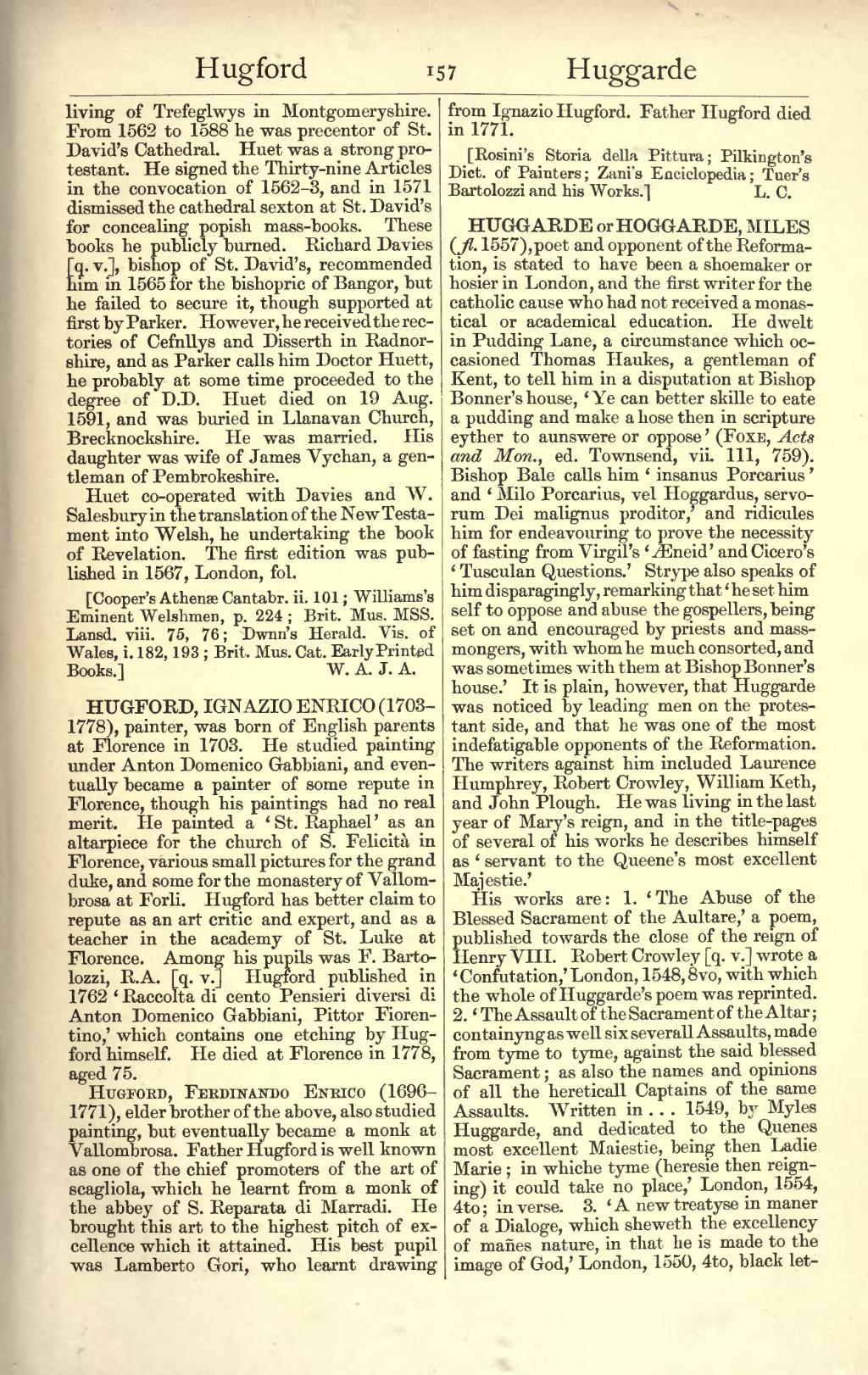living of Trefeglwys in Montgomeryshire. From 1562 to 1588 he was precentor of St. David's Cathedral. Huet was a strong protestant. He signed the Thirty-nine Articles in the convocation of 1562-3, and in 1571 dismissed the cathedral sexton at St. David's for concealing popish mass-books. These books he publicly burned. Richard Davies [q.v.], bishop of St. David's, recommended him in 1565 for the bishopric of Bangor, but he failed to secure it, though supported at first by Parker. However, he received the rectories of Cefnllys and Disserth in Radnorshire, and as Parker calls him Doctor Huett, he probably at some time proceeded to the degree of D.D. Huet died on 19 Aug. 1591, and was buried in Llanavan Church, Brecknockshire. He was married. His daughter was wife of James Vychan, a gentleman of Pembrokeshire.
Huet co-operated with Davies and W. Salesbury in the translation of the New Testament into Welsh, he undertaking the book of Revelation. The first edition was published in 1567, London, fol.
[Cooper's Athenæ Cantabr. ii. 101; Williams's Eminent Welshmen, p. 224; Brit. Mus. MSS. Lansd. viii. 75, 76; Dwnn's Herald. Vis. of Wales, i. 182, 193; Brit. Mus. Cat. Early Printed Books.]
HUGFORD, IGNAZIO ENRICO (1703–1778), painter, was born of English parents at Florence in 1703. He studied painting under Anton Domenico Gabbiani, and eventually became a painter of some repute in Florence, though his paintings had no real merit. He painted a `St. Raphael' as an altarpiece for the church of S. Felicità in Florence, various small pictures for the grand duke, and some for the monastery of Vallombrosa at Forli. Hugford has better claim to repute as an art critic and expert, and as a teacher in the academy of St. Luke at Florence. Among his pupils was F. Bartolozzi, R.A. [q.v.] Hugford published in 1762 'Raccolta di cento Pensieri diversi di Anton Domenico Gabbiani, Pittor Fiorentino,' which contains one etching by Hugford himself. He died at Florence in 1778, aged 75.
Hugford, Ferdinando Enrico (1696-1771), elder brother of the above, also studied painting, but eventually became a monk at Vallombrosa. Father Hugford is well known as one of the chief promoters of the art of scagliola, which he learnt from a monk of the abbey of S. Reparata di Marradi. He brought this art to the highest pitch of excellence which it attained. His best pupil was Lamberto Gori, who learnt drawing from Ignazio Hugford. Father Hugford died in 1771.
[Rosini's Storia della Pittura; Pilkington's Dict. of Painters; Zani's Enciclopedia; Tuer's Bartolozzi and his Works.]
HUGGARDE or HOGGARDE, MILES (fl. 1557), poet and opponent of the Reformation, is stated to have been a shoemaker or hosier in London, and the first writer for the catholic cause who had not received a monastical or academical education. He dwelt in Pudding Lane, a circumstance which occasioned Thomas Haukes, a gentleman of Kent, to tell him in a disputation at Bishop Bonner's house, 'Ye can better skille to eate a pudding and make a hose then in scripture eyther to aunswere or oppose' (Foxe, Acts and Mon., ed. Townsend, vii. 111, 759). Bishop Bale calls him `insanus Porcarius' and 'Milo Porcarius, vel Hoggardus, servorum Dei malignus proditor,' and ridicules him for endeavouring to prove the necessity of fasting from Virgil's `Æneid' and Cicero's `Tusculan Questions.' Strype also speaks of him disparagingly, remarking that 'he set him self to oppose and abuse the gospellers, being set on and encouraged by priests and massmongers, with whom he much consorted, and was sometimes with them at Bishop Bonner's house.' It is plain, however, that Huggarde was noticed by leading men on the protestant side, and that he was one of the most indefatigable opponents of the Reformation. The writers against him included Laurence Humphrey, Robert Crowley, William Keth, and John Plough. He was living in the last year of Mary's reign, and in the title-pages of several of his works he describes himself as 'servant to the Queene's most excellent Majestie.'
His works are : 1. 'The Abuse of the Blessed Sacrament of the Aultare,' a poem, published towards the close of the reign of Henry VIII. Robert Crowley [q.v.] wrote a 'Confutation,' London, 1548, 8vo, with which the whole of Huggarde's poem was reprinted. 2. 'The Assault of the Sacrament of the Altar; containyng as well six severall Assaults, made from tyme to tyme, against the said blessed Sacrament; as also the names and opinions of all the hereticall Captains of the same Assaults. Written in … 1549, by Myles Huggarde, and dedicated to the Quenes most excellent Maiestie, being then Ladie Marie; in whiche tyme (heresie then reigning) it could take no place,' London, 1554, 4to; in verse. 3. 'A new treatyse in maner of a Dialoge, which sheweth the excellency of maňes nature, in that he is made to the image of God,' London, 1550, 4to, black let-
